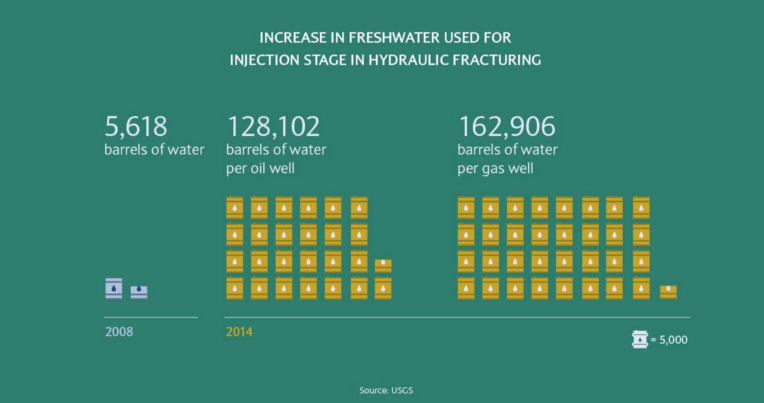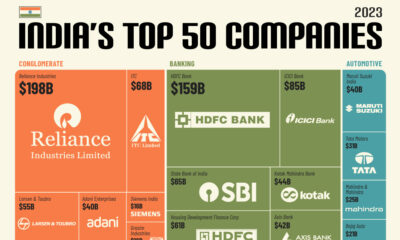Energy
The Next Big Hurdle for Oil and Gas is Water Use
In The Rime of the Ancient Mariner from 1834, English poet Samuel Taylor Coleridge famously quipped “Water, water, everywhere / But not a drop to drink”. The lines speak to the irony of sailing the high seas: there’s unfathomable amounts of water in every direction, but it’s definitely not going to quench the thirst of any sailor.
Surprisingly, the situation is not as different on land as you might think.
In some counties in the U.S., especially those with lots of oil and gas activity, there are billions of gallons of waste water, brackish water, or saline water that aren’t potable for human consumption. At the same time, these counties are receiving limited rainfall, and freshwater has become an increasingly scarce and valuable commodity.
Water Innovation is Needed
The fact is, horizontal drilling and fracking operations use large amounts of water. In 2008, an average of just 5,618 barrels of water were used for the injection stage of fracking according to the USGS. In 2014, that ballooned to 128,102 barrels of water for a oil well, and 162,906 barrels for a gas well.
Simultaneously, the Government Accountability Office estimates that 40 of 50 states have at least one region that will face some kind of water shortage by 2023. This crisis has increased social and regulatory pressures on oil and gas firms, while making the supply of usable water less dependable.
Today’s infographic comes to us from Barclays Bank, and it details this situation in depth. Further, Barclays explains how oil and gas companies will need to innovate their way out of the problem to secure new water supply and reduce costs – all while maintaining a social license to operate.

Barclays sees this problem as an opportunity: by re-thinking water use and disposal, and by turning recycled water into a new resource for other industries, oil and gas can decrease costs while giving a boost to their social license to operate.
Lithium
Ranked: The Top 10 EV Battery Manufacturers in 2023
Asia dominates this ranking of the world’s largest EV battery manufacturers in 2023.

The Top 10 EV Battery Manufacturers in 2023
This was originally posted on our Voronoi app. Download the app for free on iOS or Android and discover incredible data-driven charts from a variety of trusted sources.
Despite efforts from the U.S. and EU to secure local domestic supply, all major EV battery manufacturers remain based in Asia.
In this graphic we rank the top 10 EV battery manufacturers by total battery deployment (measured in megawatt-hours) in 2023. The data is from EV Volumes.
Chinese Dominance
Contemporary Amperex Technology Co. Limited (CATL) has swiftly risen in less than a decade to claim the title of the largest global battery group.
The Chinese company now has a 34% share of the market and supplies batteries to a range of made-in-China vehicles, including the Tesla Model Y, SAIC’s MG4/Mulan, and various Li Auto models.
| Company | Country | 2023 Production (megawatt-hour) | Share of Total Production |
|---|---|---|---|
| CATL | 🇨🇳 China | 242,700 | 34% |
| BYD | 🇨🇳 China | 115,917 | 16% |
| LG Energy Solution | 🇰🇷 Korea | 108,487 | 15% |
| Panasonic | 🇯🇵 Japan | 56,560 | 8% |
| SK On | 🇰🇷 Korea | 40,711 | 6% |
| Samsung SDI | 🇰🇷 Korea | 35,703 | 5% |
| CALB | 🇨🇳 China | 23,493 | 3% |
| Farasis Energy | 🇨🇳 China | 16,527 | 2% |
| Envision AESC | 🇨🇳 China | 8,342 | 1% |
| Sunwoda | 🇨🇳 China | 6,979 | 1% |
| Other | - | 56,040 | 8% |
In 2023, BYD surpassed LG Energy Solution to claim second place. This was driven by demand from its own models and growth in third-party deals, including providing batteries for the made-in-Germany Tesla Model Y, Toyota bZ3, Changan UNI-V, Venucia V-Online, as well as several Haval and FAW models.
The top three battery makers (CATL, BYD, LG) collectively account for two-thirds (66%) of total battery deployment.
Once a leader in the EV battery business, Panasonic now holds the fourth position with an 8% market share, down from 9% last year. With its main client, Tesla, now sourcing batteries from multiple suppliers, the Japanese battery maker seems to be losing its competitive edge in the industry.
Overall, the global EV battery market size is projected to grow from $49 billion in 2022 to $98 billion by 2029, according to Fortune Business Insights.
-

 Travel1 week ago
Travel1 week agoAirline Incidents: How Do Boeing and Airbus Compare?
-

 Markets3 weeks ago
Markets3 weeks agoVisualizing America’s Shortage of Affordable Homes
-

 Green3 weeks ago
Green3 weeks agoRanked: Top Countries by Total Forest Loss Since 2001
-

 Money2 weeks ago
Money2 weeks agoWhere Does One U.S. Tax Dollar Go?
-

 Misc2 weeks ago
Misc2 weeks agoAlmost Every EV Stock is Down After Q1 2024
-

 AI2 weeks ago
AI2 weeks agoThe Stock Performance of U.S. Chipmakers So Far in 2024
-

 Markets2 weeks ago
Markets2 weeks agoCharted: Big Four Market Share by S&P 500 Audits
-

 Real Estate2 weeks ago
Real Estate2 weeks agoRanked: The Most Valuable Housing Markets in America















